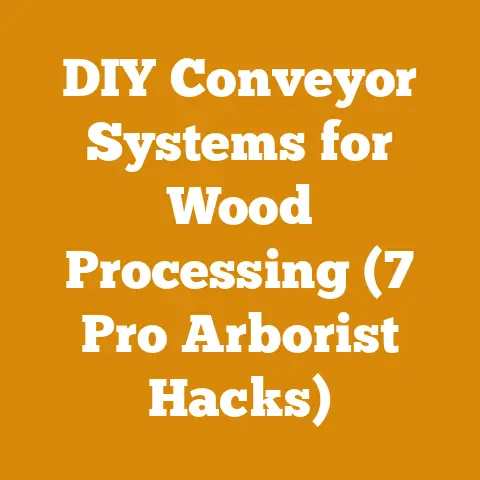How to Burn Brush Pile Safely (5 Pro Woodcutting Tips)
That knot in your stomach, the one that tightens when you think about that looming brush pile in your backyard… I know it well. For years, I wrestled with the same anxiety – the fear of a runaway fire, the potential damage, the sheer responsibility of it all. But over time, I’ve learned to not only manage that fear, but to transform it into a controlled, safe, and even somewhat satisfying process. Burning a brush pile doesn’t have to be a gamble. It can be a calculated task, guided by knowledge, preparation, and a healthy respect for the elements. This guide is my attempt to share that knowledge with you, to turn that knot of anxiety into a feeling of confidence and control. These aren’t just tips; they’re lessons hard-earned through experience, mistakes, and a deep connection to the land.
How to Burn a Brush Pile Safely: 5 Pro Woodcutting Tips
1. The Pre-Burn Reconnaissance: Choosing the Right Day and Location
Burning a brush pile is about more than just lighting a match. It’s about understanding the environment and respecting its power. My first piece of advice, and arguably the most crucial, is to meticulously plan your burn based on weather conditions and location.
Weather Wisdom: Understanding the Fire Triangle
Before even thinking about striking a match, I check the weather forecast – not just for the day of the burn, but also for the days leading up to it. You need to understand the fire triangle: heat, fuel, and oxygen. Remove or control one, and you control the fire.
- Wind Speed: This is the biggest variable. I never burn if the wind speed is predicted to be above 10 mph. Gusts can carry embers long distances, turning a controlled burn into a wildfire in minutes. Use a reliable weather app or website that provides hourly wind forecasts. Look for sustained winds, not just averages.
- Data Point: A study by the National Fire Protection Association (NFPA) shows that wind is a contributing factor in over 70% of uncontrolled brush fires.
- Humidity: High humidity (above 50%) means the air is saturated with moisture, making it harder for the fire to spread. Low humidity (below 30%) creates a tinderbox. Aim for a humidity level between 30% and 50%.
- Technical Requirement: Wood moisture content is directly related to humidity. Firewood with a moisture content above 20% is difficult to burn efficiently and produces more smoke.
- Rainfall: Recent rainfall is your best friend. It saturates the surrounding vegetation, creating a natural firebreak. If there hasn’t been rain in a week or more, I’ll postpone the burn or consider wetting down the area around the pile.
- Personal Experience: I once ignored a weather advisory and burned a brush pile on a seemingly calm day. A sudden gust of wind carried embers into a nearby field of dry grass. I managed to extinguish it quickly, but the lesson was learned: never underestimate the power of the wind.
Location, Location, Location: Creating a Safe Zone
The location of your brush pile is just as important as the weather. You need to create a firebreak – a clear area around the pile that deprives the fire of fuel.
- Minimum Clearance: I recommend a minimum of 10 feet of clearance around the brush pile, cleared down to bare earth. This means removing all vegetation, dry leaves, and flammable materials. In areas with dry grass or pine needles, I increase the clearance to 20 feet or more.
- Visual Example: Imagine a circle with a diameter of at least 20 feet, with your brush pile in the center. That entire area must be free of anything that can burn.
- Distance from Structures: Keep the brush pile at least 50 feet away from any buildings, fences, or other structures. If you have overhead power lines, increase the distance to at least 100 feet.
- Safety Code: Many local ordinances require a minimum distance from structures for open burning. Check with your local fire department or municipality for specific regulations.
- Slope: Avoid burning brush piles on steep slopes. Fire tends to travel uphill quickly. If you must burn on a slope, place the pile at the bottom of the slope and clear a wider firebreak above it.
- Practical Tip: If possible, create a secondary firebreak by wetting down the area around the primary firebreak. A garden hose or sprinkler can be very effective.
- Soil Type: The type of soil can also affect the spread of fire. Sandy soil drains quickly and dries out faster than clay soil, making it more prone to fire. If you have sandy soil, be extra vigilant about creating a wide firebreak and keeping the area wet.
2. Brush Pile Construction: Building for Efficiency and Safety
How you build your brush pile directly impacts how efficiently and safely it burns. A poorly constructed pile can smolder for days, produce excessive smoke, and increase the risk of the fire spreading.
The Teepee Method: Promoting Airflow and Combustion
I prefer the teepee method for building brush piles. This involves arranging the brush in a cone shape, with the larger pieces at the bottom and the smaller pieces at the top.
- Advantages of the Teepee Method:
- Improved Airflow: The cone shape allows air to circulate freely through the pile, promoting more complete combustion.
- Faster Burning: The smaller pieces at the top ignite quickly, creating a hot, efficient fire that consumes the larger pieces below.
- Reduced Smoke: More complete combustion means less smoke.
- Construction Steps:
- Start with a Foundation: Lay down a base of larger logs or branches to elevate the pile off the ground. This allows air to circulate underneath the pile, further improving combustion.
- Measurement: The foundation should be at least 6 inches off the ground.
- Arrange the Brush: Lean the brush against the foundation, forming a cone shape. Place the larger pieces at the bottom and the smaller pieces at the top.
- Leave an Opening: Leave a small opening at the base of the teepee to allow for easy ignition and airflow.
- Visual Example: Think of building a campfire. The same principles apply to building a brush pile.
- Start with a Foundation: Lay down a base of larger logs or branches to elevate the pile off the ground. This allows air to circulate underneath the pile, further improving combustion.
- Alternative Methods:
- The Log Cabin Method: This involves stacking the brush in a square or rectangular shape, similar to building a log cabin. This method is good for burning larger logs and branches, but it doesn’t promote airflow as well as the teepee method.
- The Random Pile Method: This is the least efficient and safest method. It involves simply piling the brush in a heap. This method produces a lot of smoke and increases the risk of the fire spreading.
Wood Types and Moisture Content: Optimizing for Clean Burning
The type of wood in your brush pile and its moisture content significantly affect how the fire burns.
- Hardwoods vs. Softwoods: Hardwoods (like oak, maple, and ash) burn hotter and longer than softwoods (like pine, fir, and spruce). However, softwoods ignite more easily. A mix of hardwoods and softwoods is ideal.
- Data Point: Hardwoods have a higher density than softwoods, which means they contain more energy per unit volume.
- Moisture Content: Dry wood burns much more efficiently and produces less smoke than wet wood. Ideally, the wood in your brush pile should have a moisture content of less than 20%.
- Technical Requirement: Firewood is typically considered “seasoned” when its moisture content is below 20%. This can take anywhere from 6 months to 2 years, depending on the type of wood and the climate.
- Practical Tip: You can use a moisture meter to check the moisture content of the wood. These meters are relatively inexpensive and can be found at most hardware stores.
- Green Wood: Avoid burning green wood (freshly cut wood) if possible. Green wood has a high moisture content and produces a lot of smoke. If you must burn green wood, mix it with dry wood to improve combustion.
- Personal Experience: I once tried to burn a brush pile that was mostly green wood. It smoldered for days, producing a thick, acrid smoke that irritated my neighbors. I learned my lesson: dry wood is essential for a clean, efficient burn.
3. Essential Gear and Preparation: Equipping Yourself for Success
Burning a brush pile safely requires more than just a match and a pile of wood. You need the right gear and a solid plan.
Safety Equipment: Protecting Yourself and Your Property
- Water Source: This is non-negotiable. I always have a water source readily available, such as a garden hose connected to a water supply or several buckets of water.
- Recommendation: A garden hose with a spray nozzle is ideal for quickly extinguishing small fires.
- Shovel and Rake: These tools are essential for controlling the fire and preventing it from spreading. Use the shovel to smother flames with dirt and the rake to clear away burning debris.
- Tool Specification: A long-handled shovel and a metal rake are the best options.
- Fire Extinguisher: A portable fire extinguisher is a valuable backup in case the fire gets out of control. Make sure the extinguisher is rated for Class A fires (fires involving ordinary combustibles like wood and paper).
- Safety Code: Ensure your fire extinguisher is properly charged and inspected regularly.
- Protective Clothing: Wear appropriate protective clothing, including:
- Long Sleeves and Pants: These will protect your skin from sparks and embers.
- Leather Gloves: Protect your hands from heat and burns.
- Eye Protection: Safety glasses or goggles will protect your eyes from smoke and debris.
- Sturdy Boots: Protect your feet from burns and injuries.
- First-Aid Kit: Keep a well-stocked first-aid kit on hand in case of minor injuries.
Notification and Communication: Keeping Everyone Informed
Before you light the fire, it’s crucial to notify your neighbors and the local fire department (if required).
- Neighbors: Let your neighbors know when and where you plan to burn the brush pile. This will prevent them from being alarmed by the smoke and flames.
- Practical Tip: A simple phone call or a friendly visit is usually sufficient.
- Fire Department: Some municipalities require you to obtain a burning permit before you can burn a brush pile. Check with your local fire department or municipality for specific regulations.
- Safety Code: Failure to obtain a required burning permit can result in fines or other penalties.
- Emergency Contact: Make sure someone knows your plans and has your contact information in case of an emergency.
4. Ignition and Monitoring: The Art of Controlled Burning
Lighting the fire is just the beginning. You need to monitor it closely and control its spread.
Safe Ignition Techniques: Starting the Fire Smart
- Choose Your Ignition Method: Several methods can be used to ignite a brush pile, including:
- Matches and Kindling: This is the simplest and most common method. Use dry kindling (small twigs, paper, or cardboard) to start the fire.
- Propane Torch: A propane torch can be used to quickly ignite the brush pile. Be careful not to overheat the torch or get too close to the flames.
- Drip Torch: A drip torch is a specialized tool that dispenses a mixture of diesel fuel and gasoline. It’s commonly used for controlled burns in forestry and agriculture. However, it requires specialized training and is not recommended for home use.
- Ignition Procedure:
- Place the Kindling: Place the kindling at the base of the teepee, in the opening you created earlier.
- Light the Kindling: Use a match or lighter to ignite the kindling.
- Add More Fuel: As the kindling catches fire, gradually add more small pieces of wood.
- Monitor the Flames: Watch the flames carefully and add more fuel as needed to keep the fire burning.
- Safety Precautions:
- Never Use Flammable Liquids: Never use gasoline, kerosene, or other flammable liquids to start a fire. These liquids can explode and cause serious injuries.
- Stay Upwind: Position yourself upwind of the fire to avoid inhaling smoke and embers.
- Keep a Safe Distance: Stay at least 10 feet away from the flames.
Continuous Monitoring: Keeping the Fire in Check
- Never Leave the Fire Unattended: This is the most important rule of controlled burning. Never leave the fire unattended, even for a few minutes.
- Watch for Spot Fires: Spot fires are small fires that ignite outside the main firebreak. They can be caused by embers carried by the wind. Be vigilant about watching for spot fires and extinguishing them immediately.
- Practical Tip: Regularly patrol the area around the firebreak to check for spot fires.
- Adjust the Fuel: As the fire burns, adjust the fuel to control its intensity. Add more fuel to increase the heat or remove fuel to reduce the heat.
- Monitor the Weather: Keep an eye on the weather conditions. If the wind picks up or the humidity drops, be prepared to extinguish the fire.
- Night Burning: I never burn brush piles at night. It’s much harder to see spot fires in the dark, and the risk of the fire spreading increases significantly.
5. Extinguishment and Aftercare: Ensuring the Fire is Truly Out
The job isn’t done when the flames die down. You need to ensure the fire is completely extinguished and won’t reignite.
Complete Extinguishment: Smothering the Embers
- Water Saturation: The best way to extinguish a brush pile is to saturate it with water. Use a garden hose or buckets of water to thoroughly wet down the entire pile.
- Technical Requirement: Ensure the water penetrates deep into the pile, reaching all the embers.
- Stirring and Mixing: Use a shovel or rake to stir the ashes and mix them with water. This will help to cool down the embers and prevent them from reigniting.
- Smothering with Dirt: If water is not available, you can smother the embers with dirt. Use a shovel to cover the entire pile with a thick layer of dirt.
- Limitation: Smothering with dirt is not as effective as saturating with water, and it may take longer to extinguish the fire completely.
Post-Burn Monitoring: Preventing Reignition
- Check for Hot Spots: After you’ve extinguished the fire, continue to monitor the area for hot spots. Use your hand to feel the ground for warmth. If you find any hot spots, saturate them with water or cover them with dirt.
- Repeat the Process: Repeat the extinguishing process as needed until you’re sure the fire is completely out.
- Regular Inspection: Inspect the area regularly for several days after the burn. Even after the fire appears to be completely extinguished, embers can smolder underground for days and reignite.
- Personal Experience: I once thought I had extinguished a brush pile completely, only to find it reignited three days later. Now, I always inspect the area regularly for at least a week after the burn.
- Ash Disposal: Once you’re sure the fire is completely out, you can dispose of the ashes. The ashes can be used as a soil amendment in your garden, but be sure to spread them thinly and avoid using them on acid-loving plants.
Burning a brush pile safely requires careful planning, preparation, and execution. By following these tips, you can minimize the risk of fire and protect yourself, your property, and the environment. Remember, safety is always the top priority. Don’t hesitate to postpone the burn if the weather conditions are unfavorable or if you’re not fully prepared. A little extra caution can go a long way in preventing a disaster. Now, go out there and conquer that brush pile with confidence!






